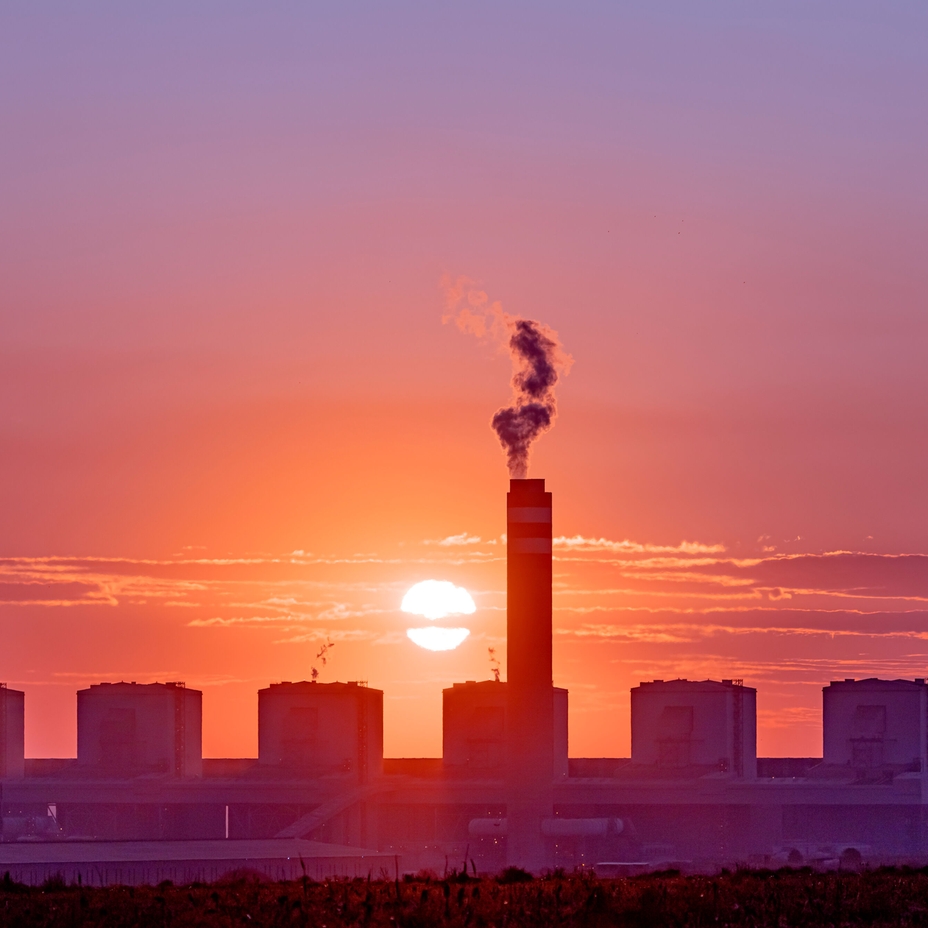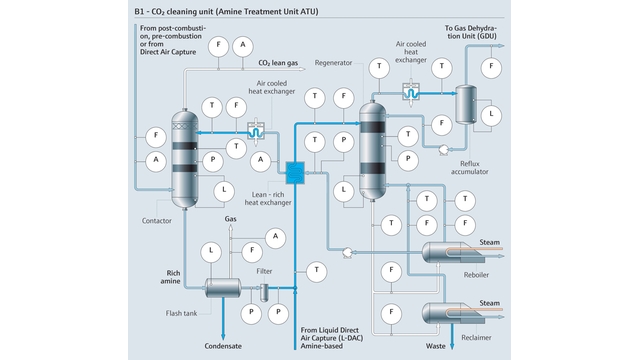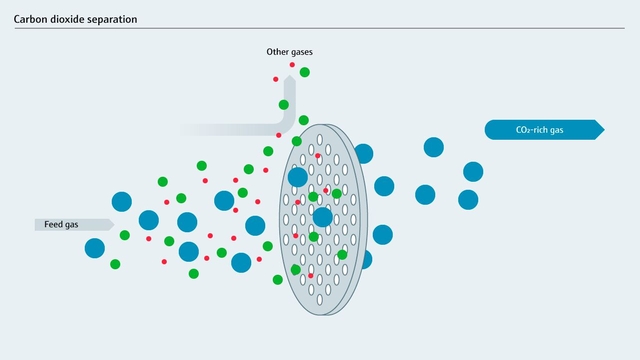Investigating modern carbon capture technologies
Capturing CO₂ is the first step in industrial carbon management. Once collected, CO₂ powers processes or is stored long-term, driving sustainable environmental change

In brief
- Most carbon dioxide emissions result from combustion. Post-combustion carbon capture involves collecting CO₂ from a process’ flue gas stream. This method is relatively easy to apply at existing facilities as it necessitates no process modifications.
- Amine gas treatment is the most common carbon capture method. It uses amine solutions to absorb carbon dioxide, achieving up to 90% capture efficiency. However, it is energy-intensive and requires regular solvent replenishment.
- Membrane-based capture is a lesser-used carbon capture method that uses specialized membranes to separate CO₂ from other gases. It consumes less energy than amine treatment but generally has lower capture efficiency.
- Researchers are experimenting with other capture methods, but these alternative approaches face significant challenges, including high costs, energy requirements and scalability limitations.
- Widespread carbon capture adoption requires overcoming the associated costs and limitations of current technologies. Although it is an important component, it is just a single aspect of broader industrial sustainability strategies.
Adding carbon capture to the emissions reduction narrative
In response to global efforts to reduce greenhouse gas (GHG) emissions, many process manufacturers are incorporating various efficiency enhancements and green power initiatives into their operations. CO₂ capture techniques, which catch and store this gas, offer a promising solution. However, widespread adoption depends on advancing the capabilities and reducing the costs of the required technology to make it more feasible.
For combustion-related carbon capture, there are two distinct approaches: pre- and post-combustion. Pre-combustion capture intercepts CO₂ prior to firing through methods such as gasification and reforming.
By contrast, post-combustion capture occurs downstream of fuel combustion in the primary process. It uses solvents or other methods to collect carbon dioxide directly from the flue gas. This web page focuses on post-combustion capture. While advantageous for its retrofitting potential and technological maturity, it is not as efficient as pre-combustion capture.
Insights
Post-combustion capture occurs downstream of fuel combustion in the primary process. It uses solvents or other methods to collect CO₂ directly from the flue gas.
Amine gas treatment
Amine gas treatment is the most widely used carbon capture method in industrial settings. This post-combustion technique leverages the chemical properties of amine solutions, such as monoethanolamine, which exhibit a strong affinity for bonding with carbon dioxide. The process consists of:
1. Flue gas pretreatment
The flue gas undergoes a cleaning process to remove dust, particulate matter, sulfurous compounds and other contaminants. This pretreatment protects the amine solution and equipment from fouling and corrosion. The hot flue gas is then cooled to an optimal temperature (around 40-60 °C/104-140 °F) for efficient carbon dioxide absorption by the amine solution.
2. Carbon dioxide absorption
The cooled flue gas enters the bottom of an absorption tower, typically a cylindrical vessel filled with packing material to enhance gas-liquid contact. A counter-flowing stream of amine solution is introduced at the top of the tower. As the flue gas rises through the tower, it contacts the descending amine solution. Then CO₂ in the flue gas forms a reversible bond with the amine molecules, removing it from the gas stream.
3. Carbon dioxide-rich amine solution transfer
Carbon dioxide-rich amine solution transfer: the carbon dioxide-rich amine solution is pumped to another tower called the desorber or regenerator. This stream is meticulously measured using Raman spectroscopic instrumentation to ensure efficiency in the subsequent regeneration step.
4. Carbon dioxide regeneration
In the desorber, the carbon dioxide-rich amine solution is heated, typically by steam injection to around 110°C/230°F. This heat severs the bond between the amine and carbon dioxide. The regenerated amine solution, now depleted of carbon dioxide, flows to the bottom of the regenerator.
5. Amine solution cooling and recirculation
Amine solution cooling and recirculation: the hot, regenerated amine solution passes through a heat exchanger, transferring some of its heat to the incoming carbon dioxide-rich solution and improving energy efficiency. Further cooling brings the amine solution back to the optimal temperature for carbon dioxide absorption and the cooled amine solution is then pumped back to the top of the absorption tower to repeat the cycle.
6. Carbon dioxide compression and processing
The carbon dioxide released from the top of the regenerator is compressed to increase its density for easier transportation or storage. This outgoing stream is often analyzed for purity using TDLAS instrumentation. Depending on the intended application, the carbon dioxide may undergo further purification steps to remove contaminants.

Amine gas treatment exhibits CO₂ capture efficiency rates regularly exceeding 90%. However, regeneration is especially energy-intensive and the amine solution used throughout the process degrades over time, requiring replenishment. Researchers are working to address these challenges by exploring more energy-efficient regeneration methods, such as using waste heat from industrial processes. They are also developing more robust amine solutions with higher thermal stability and resistance to degradation.
Insights
Amine gas treatment exhibits CO₂ capture efficiency rates regularly exceeding 90%. However, regeneration is especially energy-intensive and the amine solution used throughout the process degrades over time, requiring replenishment.
Membrane-based capture
Membrane-based carbon capture is a lesser-used method that leverages the selective permeability of specialized membranes to remove carbon dioxide from flue gas streams. These membranes often comprised of polymers or ceramic materials, acting as molecular gatekeepers. They permit CO₂ to pass through while blocking other gases. The primary advantage to this approach is its lower energy requirement compared to high-temperature amine gas regeneration.
The major steps are:
- Flue gas pretreatment: before entering the membrane system, the flue gas undergoes a cleaning process, typically filtration and scrubbing. This step removes dust, particulate matter and other impurities that can clog or damage delicate membrane pores. The flue gas is often cooled and humidity is adjusted to optimal levels for the specific membrane material in use. This ensures efficient carbon dioxide separation and prevents condensation buildup within the membrane system.
- Membrane separation: the pretreated flue gas is directed across the membrane, which acts as a selective barrier. Differences in molecular size, structure and affinity to the membrane material cause carbon dioxide molecules to traverse the membrane faster than other gases in the stream, such as nitrogen.This results in two product gas streams: permeate and retentate. The permeate, which is rich in carbon dioxide, passes through the membrane and is collected for further processing. The retentate, depleted in CO₂, contains the remaining gases. It is either released into the atmosphere or diverted back to the primary industrial process.
- Carbon dioxide compression and conditioning: the carbon dioxide-rich permeate stream is compressed to increase its density for easier transportation or storage. Depending on the intended application, the carbon dioxide may undergo further purification steps to remove contaminants.
In addition to low energy requirements, membrane systems maintain a small footprint, making them ideal for deployment in settings with limited space. However, membrane-based capture is less efficient than amine treatment, and slight variations in gas stream composition, pressure and temperature can negatively affect performance.

Experimental methods
Amine treatment and membrane-based techniques are the only post-combustion carbon capture methods currently in use at scale, but researchers are exploring other approaches as well.
The first of these is direct air capture (DAC), which scrubs carbon dioxide directly from ambient air. This is done using high-powered fans that draw air through specialized sorbent materials, such as solid amines or hydroxide solutions that chemically bind with carbon dioxide. Once the sorbent material is saturated, it is heated to release the captured carbon dioxide, which is then collected for utilization or storage.
DAC provides a potential pathway for capturing emissions from automobiles and other sources. However, it faces significant adoption barriers due to fragile sorbent materials , high energy requirements and cost compared to point-source capture technologies and the necessity for large-scale deployment to achieve meaningful carbon capture.
Research is exploring the use of biomass as a fuel source. Biomass, such as trees, absorbs carbon dioxide from the atmosphere as it grows. By later capturing the carbon dioxide released during combustion, users can effectively achieve negative emissions. However, biomass growth requires extensive land area, water resources and careful consideration of sustainable sourcing practices.
Increasing carbon capture viability
The widespread adoption of post-combustion carbon capture is dependent on overcoming technological and economic hurdles, not only regarding capture, but also utilization and storage. While amine gas treatment is highly efficient, it demands significant energy inputs and regular maintenance of the solvents used. In contrast, membrane-based capture has lower energy requirements but is less efficient. Both processes are also costly.
As the industry strives for net-zero objectives, strategic diversification will be essential. Achieving these goals will require a combination of process optimization, overall energy efficiency improvements, adoption of renewable resources and a commitment to carbon capture. Navigating the environmental, technological and economic trade-offs of each strategy is crucial for enhancing overall industrial sustainability in the future.



